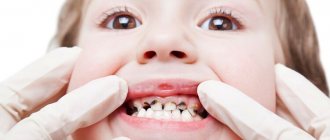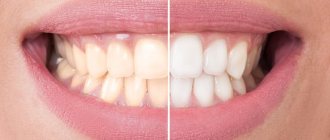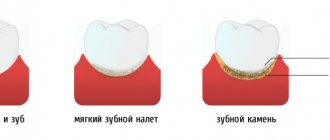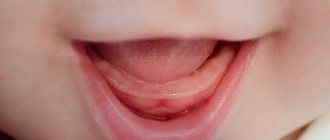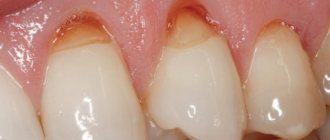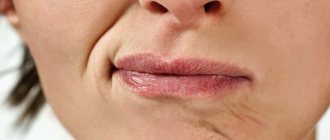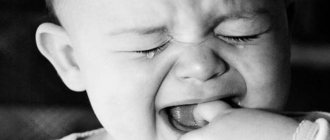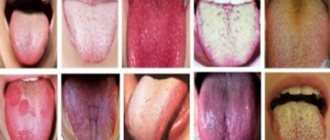Only a few months pass after the baby is born when teething begins. They are still milky, but almost until school they will help the child eat right. However, even a baby’s weak teeth often become a headache for parents. They quite often begin to break down, causing physical pain to the child and interfering with digestion. In the future, the situation may worsen, since the problem will quickly affect young molars.
Why does a child have bad baby teeth and how can you try to help your baby cope with the problem?
Causes of the problem
Enamel is the hardest tissue in the body, which is continuously exposed to mechanical, thermal and chemical stress. There are many reasons for its destruction and they can all be divided into two groups: carious and non-carious.
Carious causes
Most often, it is caries that destroys teeth, and in children this happens very quickly - in a few months, snow-white milk teeth can turn into black “stumps”. Bottle caries is a problem in the first years of life, when the use of a bottle with formula or sweet liquids at night creates a favorable atmosphere for an increase in the number of bacteria, leading to the development of caries and destruction of tooth enamel.
Non-carious causes
Often teeth are destroyed due to a lack of minerals in the enamel: calcium, potassium, phosphorus, magnesium, which enter the body with food.
The main non-carious reasons why baby teeth crumble:
Enamel hypoplasia is a serious problem in which the enamel layer on a tooth may be completely or partially absent due to abnormal processes that are formed during the formation of the rudiments of teeth. The reason is a difficult pregnancy, stress, bad habits and a lack of vitamins in the body of the expectant mother.
Visually, enamel hypoplasia looks like grooves on the enamel, through which dentin shines through. Such teeth are not protected and are more susceptible to physical and chemical stress.
Fluorosis is a disease that develops due to excess fluoride in the body. The child's teeth are covered with bright white spots. This problem is caused by drinking water with high levels of fluoride content.
Non-carious lesions also include:
- poor nutrition (lack of important substances);
- lack of fat-soluble vitamins;
- high levels of phytic acid;
- excessive sugar consumption;
- excess fluoride in the body;
- enamel defects or absence;
- heredity;
- taking antibiotics during the mother's pregnancy;
- poor oral hygiene;
- the habit of chewing on everything - pencils, pens, toys, nuts, candies;
- problems of intrauterine development;
- low quality of drinking water;
- jaw injuries resulting from a fall.
Anesthesia in pediatric dentistry
Those manipulations that an adult is able to calmly endure will become the strongest test for a child, both physically and psychologically. Pain management in pediatric dentistry is given a special place, because the psychological trauma from pain received in childhood at a dentist’s appointment will accompany a person throughout his life, and the fear of the dental office will turn into a real phobia. The use of anesthesia by pediatric dentists will remove pain and, accordingly, fear of procedures.
The use of anesthesia in pediatric dentistry has a number of features:
- for the youngest there are restrictions on the use of most products that can be used from 4 years old;
- the doctor must have experience and high qualifications to accurately calculate the active drug;
- children are afraid of treatment of baby teeth , and in general of all dental instruments, especially syringes and injections;
- Quite often, children experience allergic reactions to anesthetic drugs.
How to prevent tooth decay
What to do to prevent chipping/decay of teeth:
- ensure high-quality oral hygiene;
- limit the amount of sweets in the children's diet;
- teach your child to brush their teeth and rinse their mouth after eating;
- take your child for preventive examinations to the dentist.
Expectant mothers need to eat well, take vitamins, and treat all their teeth that need it - after all, a child’s teeth are formed in the early stages of pregnancy. Vitamins that a child should receive from food:
- Group A – butter, yolk, offal, fish, fish oil;
- Group D – pork, salmon, yolk, beef liver, fish oil;
- Group E – meat by-products, nuts, seeds, green vegetables;
- Group K – liver, yolk, butter, nuts, seeds, broccoli.
As for babies, it is necessary, if possible, to eliminate night feedings and teach them to drink water at night. You can also use xylitol - containing wipes for treating teeth, if such feedings are still present.
How to prevent dental diseases in children?
Unlike adults, caries develops in children almost asymptomatically, without causing discomfort. However, small children sometimes complain of pain in their teeth. What does this mean and what to do if a child has a toothache? Firstly, this may already be a sign of pulpitis or periodontitis. Secondly, it is necessary to visit a pediatric dentist at the first, even the most minor, complaints of the child. However, following the recommendations of doctors will help you avoid many problems:
- Parents should regularly examine the child’s oral cavity to see if the enamel has darkened, if the gums have changed color, and if there is too much plaque on the teeth.
- Prepare your diet correctly. Limiting sweets, add more vegetables and fruits. While eating, you should pay attention to how the baby chews food: if he always chews on one side, he needs to be examined by a dentist.
- Properly organize oral care. The brushes should be attractive and soft, and the toothpaste should be safe and pleasant to the taste.
- If a child has teeth grinding, you should immediately consult a doctor in order to stop the disease at the initial stage. Otherwise, this can lead to high tooth sensitivity, caries and related complications.
- In addition to home examinations, professional examinations by a pediatric dentist are mandatory.
- Examinations and treatment of a child’s baby teeth should be performed by a pediatric dentist. Such a doctor must be not only a good specialist, but also a psychologist who knows how to find the right approach to a small patient. This will help in the future to avoid the fear of the dental chair, which is typical even for many adults.
dental treatment for children, a pediatric dentist carries out preventive measures for healthy children:
- seals the fissures of chewing teeth;
- coats teeth with fluoride varnish to protect enamel;
- professionally brushes teeth.
In addition, the doctor advises parents on how to take care of their child’s oral cavity, and tells children how to brush their teeth. As soon as the first teeth appear, you need to clean your mouth every day with rubber finger brushes. Toothpaste is used for care when the child is one to one and a half years old.
Dentists have a good way to check how accurately you follow their recommendations: checking with a special coloring composition helps detect plaque on your baby’s teeth.
The time will come for baby teeth to fall out anyway...
Having learned after a visit to the doctor why the child’s teeth hurt, parents are often in no hurry to treat baby teeth, believing that the time will come for them to fall out anyway, but when the permanent teeth grow, they must be carefully monitored. This is a rather dangerous misconception that can lead to a deterioration in the child’s health, because the body is an integral system where everything is interconnected, and dental problems can become a “trigger” for many other diseases. At the same time, diseased baby teeth can lead to the development of pathologies in permanent teeth.
If baby teeth are not treated on time and they are significantly damaged, they should be removed. The resulting void in the dentition can cause problems with bite. In this case, they resort to installing orthodontic plates, and at the age of 10-12 years, braces are installed. If the incisors are removed, problems may arise with the pronunciation of individual sounds, in which case you will have to contact a speech therapist. So it is better to avoid troubles than to deal with them later; in this matter, the best solution is prevention.
In addition, acute toothache and a visit to the dentist in this case will become stressful for the child. Sedation or general anesthesia is often required.
Professional treatments
To stop tooth decay, experts recommend strengthening the enamel with the help of remineralizing agents:
- fluoridation – periodic coating with solutions containing fluorine and other useful microelements;
- artificial saturation of the enamel surface with calcium and other minerals - the dentinal tubules are sealed and the density of the enamel increases;
- ozonation – destruction of bacteria in the affected tooth tissues without injuring soft tissues, helps stop destruction and cure caries at the initial stage;
- filling of dental defects;
- prosthetics – a decaying tooth is covered with a crown to isolate it from aggressive environments and stop crumbling.
- fissure sealing – sealing the chewing surface of molars with a special filling material;
The dentist chooses the appropriate treatment method, depending on the condition of the teeth and the age of the patient.
If your teeth have already begun to decay/crumple or the first signs of caries have appeared (stains on the enamel, changes in its color), do not delay your visit to the dentist. This is when time matters!
Factors in the development of caries
One of the reasons for its occurrence is the effect of decay of carbohydrate products on teeth. Sugar enters the child's body along with food, resulting in the formation of three acids in saliva:
- ant
- propionic
- oil
Secondly, carious microorganisms act on dental tissue. Acid-forming streptococci lead to anaerobic fermentation, and lactobacilli convert fructose, glucose and sucrose into lactic acid. These acids affect tooth tissue, as well as dentin. Such impacts lead to dental defects.
Some children have bad teeth by age 2, and by age 3 they develop a type of tooth decay called bottle tooth decay.
Please note: bottle caries occurs due to the child’s consumption of sweet mixtures, syrups, and candies at an early age.
Basically, caries occurs due to:
- Genetic predisposition.
- Diseases that the mother suffered during pregnancy. Often, due to toxicosis, a woman cannot eat properly and does not receive the necessary vitamins and microelements.
- Poor immunity, poor nutrition.
- Structures of teeth. If there are large gaps between the teeth, then food particles accumulate in them and plaque quickly appears, followed by holes.
- Amounts of fluoride in dental tissue. Salts formed by fluoride, apatites, strengthen the enamel, which reduces the risk of caries. If the mother did not have enough fluoride in her body during pregnancy, then the child also has a deficiency of this substance.
- The baby's diet should not be rich in carbohydrates, as they increase the incidence of caries. This menu includes feeding with sweet formulas.
- The baby's nutrition should be complete and balanced.
- In the morning and before bed, under the supervision of an adult parent, the child should clean the oral cavity. This will be a good prevention against bad and rotten teeth.
How is pain relief performed when treating pulpitis in adolescents under 14 years of age?
Pulpitis is often accompanied by severe pain, so high-quality and safe pain relief is especially important for effective treatment and comfortable well-being of the patient.
Treatment of pulpitis in children is carried out completely without pain, for this purpose local conduction anesthesia is used. For severe pain, it is combined with intrapulpal anesthesia.
To prevent a child from having a negative reaction to an injection of an anesthetic drug, in our clinic we use local application gel anesthesia (freezing).
If there is increased anxiety, preliminary sedation is recommended; before visiting the dentist, the child can be given light sedatives - valerian, Novopassit, motherwort tincture, according to the instructions and in the dosage indicated for his age/weight.
How will caries be treated for a one-year-old child?
For young patients, the most gentle, gentle treatment is usually selected. In modern clinics, when treating young children, doctors try to ensure that the appointment time does not exceed 30 minutes.
If anesthesia is necessary, application is mainly used; in rare cases, an anesthetic injection is given. For babies under one year of age, it is preferable to treat caries using non-invasive methods, without drilling. But such therapy is justified and effective only if caries is detected early at the spot stage.
The most popular methods of treating caries in children.
- Remineralization.
Remineralizing therapy at the carious stain stage helps restore the mineral composition of the enamel, restore its strength and prevent the destruction of dental tissues. The essence of the method is that gels and pastes containing phosphorus, calcium and other components beneficial to dental health are applied to the surface of the enamel. Remineralization can be carried out both in a dental clinic and at home, using products recommended by the doctor. Home treatment is preferable for one-year-old children, because the mother or another family member will treat the teeth, and the baby will feel comfortable.
- Silvering.
Today this technique is considered outdated, although in some clinics it is still used to treat caries in children under three years of age. The essence of the method is that the enamel is coated with a 30% solution of silver nitrate, which neutralizes the activity of bacteria and stops the process of tooth decay. Among the main disadvantages of the method is a decrease in the aesthetics of the smile, because after silvering, white teeth turn black.
- Ozone therapy.
A modern non-contact method of caries treatment that is suitable for children of any age. It is based on the antibacterial effect of ozone, which neutralizes carious lesions at an early stage and disinfects the tooth. Usually ozone therapy is combined with remineralization. First, the affected area is cleaned with ozone, and then the enamel is coated with strengthening compounds.
Which treatment method to choose for a particular child is determined by the dentist after the first appointment.
Other important features of the treatment of pulpitis in permanent teeth for children under 14 years of age:
In order for the treatment of pulpitis to be successful and the patient to have no relapses or complications, it is necessary to:
- Strictly maintain sterility to avoid infection during treatment.
- Use a rubber dam to isolate the patient’s oral cavity from the manipulation field.
- Carry out a thorough filling of the canals - the voids left in them will provoke the re-development of inflammation.
- Monitor the quality of canal filling after treatment using repeated x-ray diagnostics.
- Do not forget that not only adults, but also children need high-quality fillings and dental restoration, and, sometimes, even prosthetics with ceramic inlays.
What complications can there be?
When a child is very small, even if he has very bad baby teeth, only his parents and closest people see it. It’s another matter when the baby grows up and begins to attend kindergarten and actively communicate with peers. A situation may arise that the child will begin to have psycho-emotional problems due to ridicule associated with his unaesthetic smile. But this is only one side of the “coin”. The main danger is that food is chewed worse - the digestive system suffers, and the body receives fewer nutrients. The child may begin to get sick more often and grow more slowly.
Another danger is the risk of losing a tooth or even several. After all, children's enamel and dentin are thinner, more fragile, i.e. they contain fewer minerals than adults. That is, for example, the same caries occurs more aggressively in children, quickly affecting an increasing amount of healthy tissue. And where just recently there was a small dark spot, after a couple of months a voluminous cavity may appear, and then the crown will simply break. Infection can also penetrate deep into the roots, affecting the developing permanent tooth germ. Then, in due time, it will erupt weakened, or it will not erupt at all if it dies.
What is bottle caries of baby teeth?
Bottle caries can occur almost immediately after teething if the baby is bottle-fed and cariogenic bacteria enter the newborn’s oral cavity. They begin to eat milk, which has a lot of sugar. The mouth creates a favorable environment for the proliferation of microbes. Since the incisors appear first, caries of the front teeth occurs. It develops in exactly the same way as other varieties of this pathology. Complications may arise if parents do not bring the baby to the dentist for examination.
